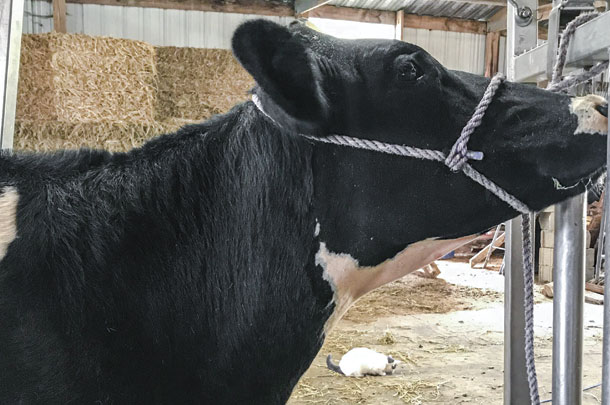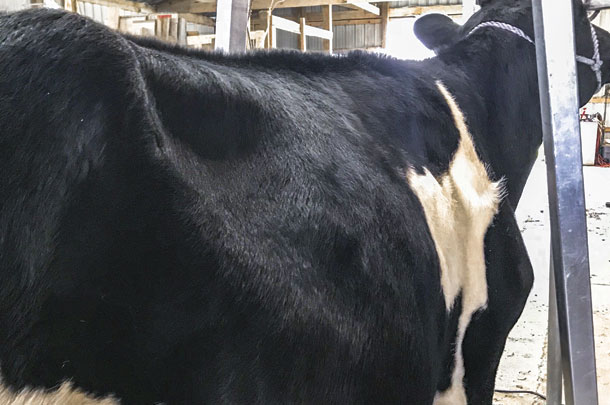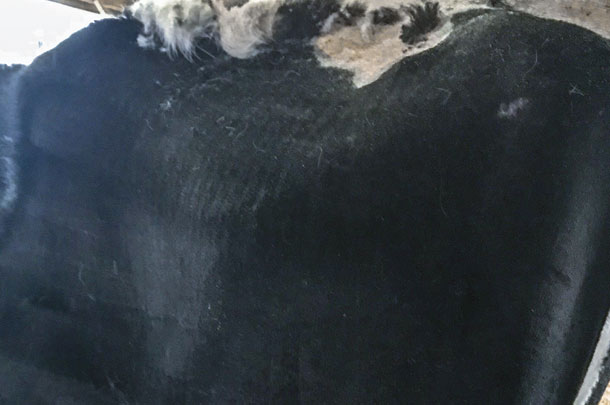If you look at the most successful show strings, they are working to get ready for the next show 365 days of the year. If your goal for 2020 is to be the best in your class, don’t sit back and wait for spring. Get out to the barn and keep your heifer moving forward.
Keep her clean
One of the most important management practices to keep your heifer growing and healthy through cold winter months is to keep her clean. Bed pans well and pick manure piles at least once each day. In the same way baby calves thrive in clean, dry environments, studies have shown heifers also thrive when they are clean and free of manure balls.
Clip off long hair
Depending on the housing you have for your heifer and the climate you live in, it’s best not to clip all of her hair off until temperatures start to warm up in early spring. According to a veteran show heifer manager, he recommends keeping the brisket, head and tail clipped all winter in cold climates in cold housing. In cool, variable weather, heifers will stay cleaner if you also clip off the hind legs up to the top of the thighs. Blow up the topline every three to four weeks and take the ends of the hair off to promote new growth.
 This is a good time to evaluate your heifer’s belly hair. Leaving belly hair is a practice that is here to stay, so we need to give it as much attention as we do to the topline. To begin, evaluate the natural depth your heifer possesses. If she lacks depth, you’re going to make it your goal to add the appearance of depth by taking good care of that hair throughout the winter.
This is a good time to evaluate your heifer’s belly hair. Leaving belly hair is a practice that is here to stay, so we need to give it as much attention as we do to the topline. To begin, evaluate the natural depth your heifer possesses. If she lacks depth, you’re going to make it your goal to add the appearance of depth by taking good care of that hair throughout the winter.
Keep it clean, blow it out as often as possible, and trim the ends of the hair off to promote even growth. If your heifer is deep-ribbed and you won’t be leaving a lot of hair in the show season, be sure to keep it clean, especially if she has white hair. Even if you are not leaving length of hair at shows, the hair has to be neat and growing uniformly to look good, which can be achieved by working it in the off months. Blow it out and clip the ends off to keep it growing nicely.
Heifers need to conserve energy for growth and, if they are using feed energy to stay warm, they aren’t able to convert it to growth energy. On the other hand, if heifers have too much hair on them on the occasional warm winter day, they sweat and then get a chill. This makes her susceptible to pneumonia. Clipping long hair off will help keep her clean, promote new hair growth and good health.

When clipping, use a plucking blade or blade that will leave hair a little longer. There is no need for a close clip during winter months. This is also an excellent time to practice your fitting skills if you are just starting out or learning new techniques. If you make a mistake, the hair will grow back quickly. Many great fitters got their start in a chilly barn in January.
Feeding
During the “off” season and when weather is cold, it’s good to feed extra energy. If you have corn silage or even a heifer TMR available, you can feed small amounts of these to help with extra energy. In addition to practicing your clipping, winter is another good time to work with your nutritionist to figure out what feed you will use during the show season. After you’ve decided on that ration, they may recommend adding cracked or rolled corn to the diet during the winter instead of TMR or corn silage.

Be careful that you don’t overfeed. If you notice your heifer putting on weight, move her to a pen with larger heifers for a few weeks so she has to work a little harder for her feed. If she appears too thin, do the opposite and put her in a pen with smaller heifers for a while. Again, it will take more feed energy than usual to keep your heifer warm and to keep her growing in the cold winter months.
Vaccinate and deworm
One of the pesky aspects of winter is the prevalence of lice that goes unnoticed because of the long hair. If you see that your heifer is itching, licking her hair and biting her tail, she probably has lice. A good practice to prevent this is to use a pour-on delousing product each time you clip off the ends of the topline hair. Every three to four weeks, blow the top up, clip the ends of the hair off, and then use pour-on down the sides of the top. Don’t pour it directly on the topline. Be sure to follow directions on the product you choose. Your heifer will be much more content, and you will have a great looking hair coat in the spring.
Just like professional athletes, the work you do in the off-season will pay off when it comes time to hit the show ring. Put in the hours and the practice now to achieve all of your 2020 goals. ![]()
PHOTO 1: Clip the head and neck to keep her from sweating on warmer winter days.
PHOTO 2: Leave some hair on your heifer in the cooler months so that her energy goes to growth.
PHOTO 3: Clip the thighs off to keep them clean and free of stuck-on manure. Photos by Katie Coyne.

-
Katie Coyne
- Owner
- Mill Wheel Dairy Show Clinics
- Email Katie Coyne








